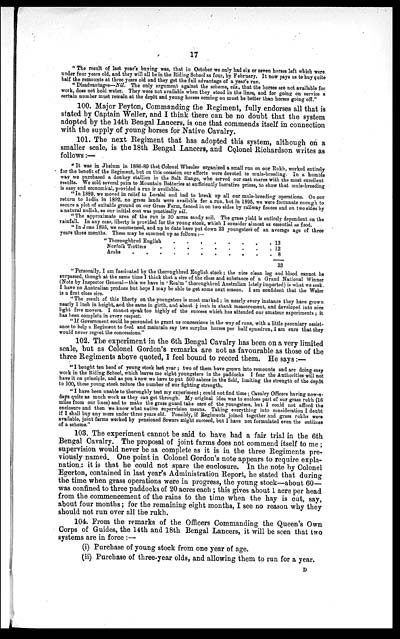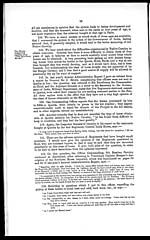Medicine - Veterinary > Civil Veterinary Departments > Annual administration report of the Civil Veterinary Department of India > 1896-1897 > Part I - Imperial report
(35) Page 17
Download files
Individual page:
Thumbnail gallery: Grid view | List view

17
"The result of last year's buying was, that in October we only had six or seven horses left which were
under four years old, and they will all be in the Riding School as four, by February. It now pays us to buy quite
half the remounts at three years old and they get the full advantage of a year's run.
"Disadvantages—Nil. The only argument against the scheme, viz., that the horses are not available for
work, does not hold water. They were not available when they stood in the lines, and for going on service a
certain number must remain at the depôt and young horses coming on must be better than horses going off."
100. Major Peyton, Commanding the Regiment, fully endorses all that is
stated by Captain Weller, and I think there can be no doubt that the system
adopted by the 14th Bengal Lancers, is one that commends itself in connection
with the supply of young horses for Native Cavalry.
101. The next Regiment that has adopted this system, although on a
smaller scale, is the 18th Bengal Lancers, and Colonel Richardson writes as
follows:—
"It was in Jhelum in 1886-89 that Colonel Wheeler organized a small run on our Rukh, worked entirely
for the benefit of the Regiment, but on this occasion our efforts were devoted to mule-breeding. In a humble
way we purchased a donkey stallion in the Salt Range, who served our cast mares with the most excellent
results. We sold several pairs to Mountain Batteries at sufficiently lucrative prices, to show that mule-breeding
is easy and economical, provided a run is available.
"In 1889, we moved in relief to Loralai and had to break up all our mule-breeding operations. On our
return to India in 1892, no grass lands were available for a run, but in 1895, we were fortunate enough to
secure a plot of suitable ground on our Grass Farm, fenced in on two sides by railway fences and on two sides by
a natural nullah, so our initial cost was practically nil.
"The approximate area of the run is 30 acres sandy soil. The grass yield is entirely dependent on the
rainfall. In any case, liberty is provided for the young stock, which I consider almost as essential as food.
"In June 1895, we commenced, and up to date have put down 33 youngsters of an average age of three
years three months. These may be summed up as follows:—
|
Thoroughbred English . . . . . . . . . |
13 |
|
Norfolk Trotter . . . . . . . . . |
12 |
|
Arabs . . . . . . . . . |
8 |
|
33 |
"Personally, I am fascinated by the thoroughbred English stock; the nice clean leg and blood cannot be
surpassed, though at the same time I think that a sire of the class and substance of a Grand National Winner
(Note by Inspector General—this we have in 'Realm' thoroughbred Australian lately imported) is what we seek.
I have no Australian produce but hope I may be able to get some next season. I am confident that the Waler
is a first class sire.
"The result of this liberty on the youngsters is most marked; in nearly every instance they have grown
nearly 1 inch in height, and the same in girth, and about ¼ inch in shank measurement, and developed into nice
light free movers. I cannot speak too highly of the success which has attended our amateur experiments; it
has been complete in every respect.
"If Government could be persuaded to grant us concessions in the way of runs, with a little pecuniary assist-
ance to help a Regiment to feed and maintain say two surplus horses per half spuadron, I am sure that they
would never regret the concessions."
102. The experiment in the 6th Bengal Cavalry has been on a very limited
scale, but as Colonel Gordon's remarks are not as favourable as those of the
three Regiments above quoted, I feel bound to record them. He says:—
"I bought ten head of young stock last year; two of them have grown into remounts and are doing easy
work in the Riding School, which leaves me eight youngsters in the paddocks. I fear the Authorities will not
have it on principle, and as you know we have to put 500 sabres in the field, limiting the strength of the depôt
to 100, these young stock reduce the number of our fighting strength.
"I have been unable to thoroughly test my experiment; could not find time; Cavalry Officers having now-a-
days quite as much work as they can get through. My original idea was to enclose part of our grass rukh (16
miles from our lines) and to make the grass guard take care of the youngsters, but I could not afford the
enclosure and then we know what native supervision means. Taking everything into consideration I doubt
if I shall buy any more under three years old. Possibly, if Regiments joined together and grass rukhs were
available, joint farms worked by pensioned Sowars might succeed, but I have not formulated even the outlines
of a scheme."
103. The experiment cannot be said to have had a fair trial in the 6th
Bengal Cavalry. The proposal of joint farms does not commend itself to me;
supervision would never be as complete as it is in the three Regiments pre-
viously named. One point in Colonel Gordon's note appears to require expla-
nation: it is that he could not spare the enclosure. In the note by Colonel
Egerton, contained in last year's Administration Report, he stated that during
the time when grass operations were in progress, the young stock—about 60—
was confined to three paddocks of 20 acres each; this gives about 1 acre per head
from the commencement of the rains to the time when the hay is cut, say,
about four months; for the remaining eight months, I see no reason why they
should not run over all the rukh.
104. From the remarks of the Officers Commanding the Queen's Own
Corps of Guides, the 14th and 18th Bengal Lancers, it will be seen that two
systems are in force:—
(i) Purchase of young stock from one year of age.
(ii) Purchase of three-year olds, and allowing them to run for a year.
D
Set display mode to: Large image | Zoom image | Transcription
Images and transcriptions on this page, including medium image downloads, may be used under the Creative Commons Attribution 4.0 International Licence unless otherwise stated. ![]()
| India Papers > Medicine - Veterinary > Civil Veterinary Departments > Annual administration report of the Civil Veterinary Department of India > 1896-1897 > Imperial report > (35) Page 17 |
|---|
| Permanent URL | https://digital.nls.uk/75503605 |
|---|




